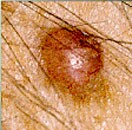
THURSDAY, June 16 (HealthDay News) — Melanoma lesions are spotted most often by patients themselves, but when dermatologists do identify them it is typically among older patients with a history of skin cancer, new research indicates.
In the study, published online June 16 in the Archives of Dermatology, researchers led by Sean T. McGuire at the University of Pittsburgh looked back at the records of 167 melanoma patients. The patients had had their cancers diagnosed and confirmed by biopsy between 2003 and late 2008.
Just over 60 percent of the melanomas had been spotted by the patients themselves, and younger patients with fewer risk factors for melanoma were mostly likely to identify lesions on their own. In fact, just 3 percent of melanomas arising in low-risk patients had been first identified during a dermatologist’s exam, the study found.
Melanomas that were discovered by a dermatologist were more likely to arise among older patients (at least 50 years of age) with a prior history of melanoma or other skin cancer, the researchers said in a news release from the journal.
The findings have implications for policies surrounding melanoma screening, the researchers noted. “Melanoma outcome is strongly determined by tumor thickness at the time of diagnosis,” they noted, and catching a lesion before it becomes too thick is key to survival. However, the researchers added, “determining which group of patients is least likely to self-detect melanoma, or to detect melanoma only at a later stage, would be useful in making more pragmatic decisions regarding the benefits of skin cancer screening and surveillance recommendations.”
Screening everyone for melanoma can have negative consequences, including costly and aggressive treatments for tumors that might have otherwise progressed very slowly. The new findings should “aid in understanding which patients will benefit most from screening for melanoma by a dermatologist,” the team said.
However, one expert took issue with the implications of the findings.
“I completely disagree with the conclusion of this study,” said Dr. Michele Greene, a dermatologist at Lenox Hill Hospital in New York City. “Only 167 patients with melanoma were used. In order to make such a conclusion, thousands of patients would have to be included in this study. Moreover, I am seeing younger patients in my practice who have had melanoma without any family history. Since it is rare for a young person to die from any kind of disease, how can it be ‘not worth’ screening younger patients and to discard a whole group of patients and assume that they will ‘find them on their own?'”
According to the U.S. National Institutes of Health, melanoma is the most lethal of all skin cancers. However, the disease is curable if caught early enough, before it has spread to the lymph nodes and other tissues and organs.
More information
Find out more about melanoma at the Skin Cancer Foundation.

